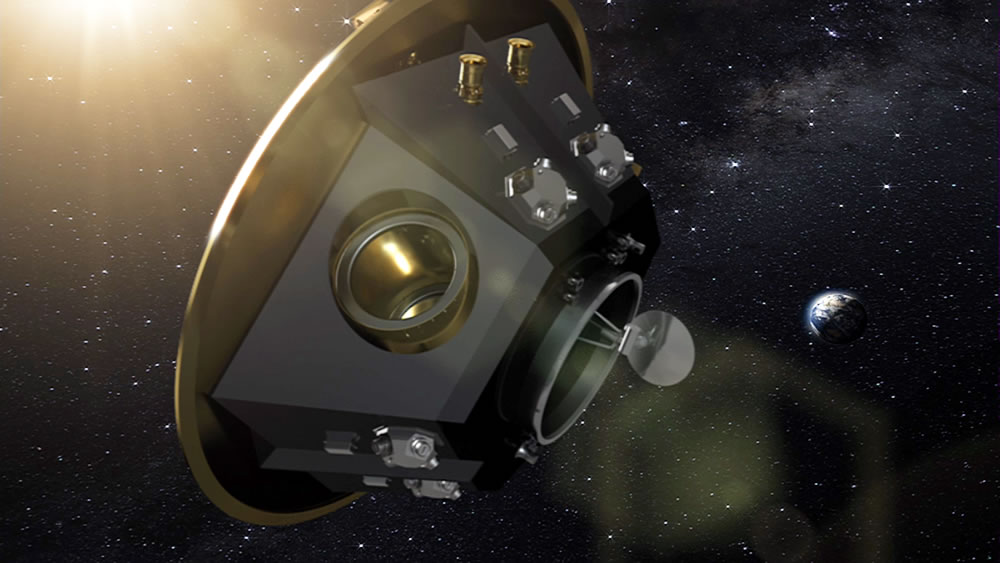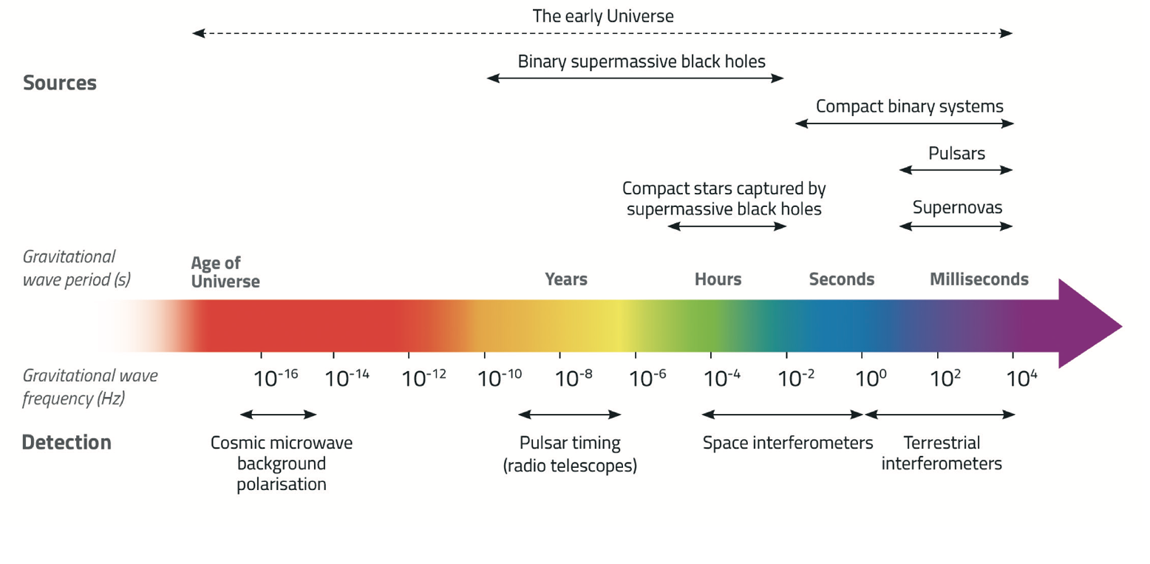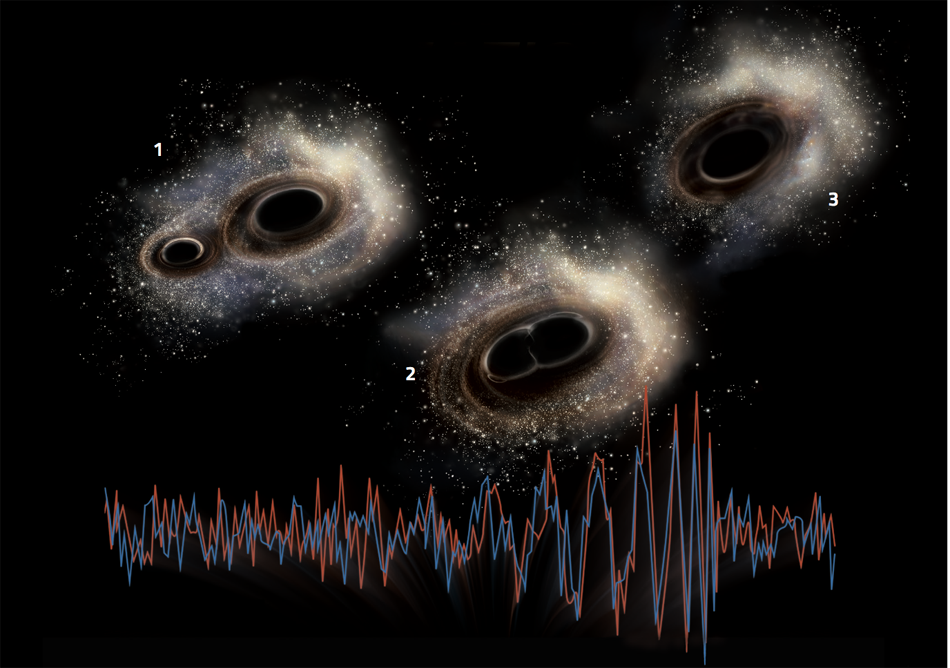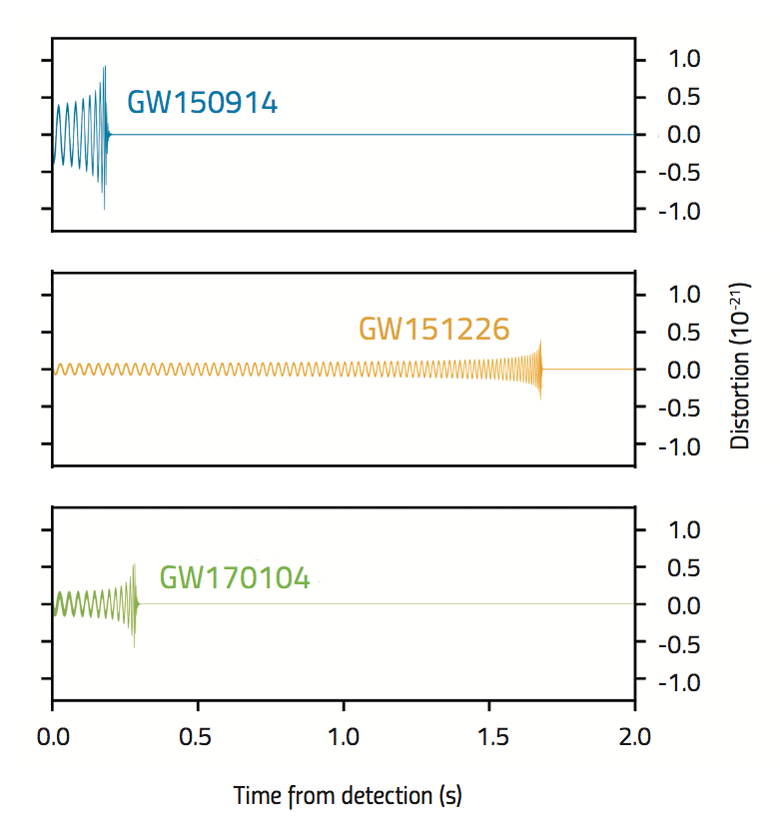Gravitational waves: a taxonomy Understand article
Gravitational waves were predicted by Einstein – but where do they come from, and what different types might there be out in the cosmos?
The scale of gravitational waves is tiny and huge at the same time. While the ripples they cause are so slight as to be almost undetectable, their wavelengths can be vast: much, much larger than the more familiar electromagnetic waves – ranging from radio waves to X-rays – used by astronomers to view space.
So what are gravitational waves? These ripples in space-time are produced whenever any mass accelerates. However, gravitational waves from sources on Earth are unlikely ever to be detectable, because objects on Earth are simply not massive enough or do not accelerate fast enough. Instead, we have to look for signals coming from sources in the cosmos, where masses and movements are on the astronomical scale.
Recently, detecting gravitational waves produced by massive celestial objects has finally become possible, so they can potentially be used as an extra tool for observing events and objects in space – an exciting prospect for today’s astronomers.

AEI/MM/exozet
The gravitational wave spectrum
Like electromagnetic waves, gravitational waves travel at the speed of light. And like the electromagnetic spectrum, the gravitational wave spectrum is extremely broad, with the different parts classified according to frequency. In general, gravitational wave frequencies are much lower than those of the electromagnetic spectrum (a few thousand hertz at most, compared to some 1016 to 1019 Hz for X-rays). Consequently, they have much larger wavelengths – ranging from hundreds of kilometres to potentially the span of the Universe.
The frequency range of a gravitational wave signal provides information about its source: the lower the frequency, the larger the mass involved. It also tells scientists which type of detector to use to look for which source, as the detector size should be comparable to the wavelength of the signal. Figure 1 shows the full range of gravitational waves, with the sources that produce them and the devices needed to detect them at the different frequencies.
Giant Earth-based interferometers like LIGO (laser interferometer gravitational-wave observatory) and Virgo (featured in Arnaud, 2017) are designed to detect gravitational waves at the top end of the frequency range, from a few tens of hertz to a few kilohertz. In addition, the LISAw1 (laser interferometer space antenna) project – a group of space interferometers – is planned for launch in about a decade. Using similar design principles to terrestrial detectors, LISA will cover gravitational wave frequencies in a lower range (1–10-5 Hz). Low-frequency gravitational waves would affect the precise regularity of the electromagnetic wave flashes detected from pulsars, providing another means of detection, this time in the range of 10-6–10-9 Hz. Finally, gravitational waves emitted in the early Universe could have left a faint imprint on the cosmic microwave background. This signal is being sought, for example by the Planck satellite, in the gravitational wave frequency range of 10-15–10-17 Hz. The wavelengths associated with these extremely low frequencies would be on the scale of the Universe itself.

Sources of gravitational waves
Among the diversity of gravitational wave sources, let’s briefly look at three sources that produce waves with frequencies in the range accessible to terrestrial detectors.
Supernovas
When a giant red star runs out of its nuclear fuel, the balance between the nuclear reactions (which pushes matter apart) and gravity (which pulls matter together) is destroyed. The star collapses until it reaches the density of nuclear matter (about 1017 kg/m3), which triggers a shockwave that ejects the external layers of the star. This phenomenon, called a type-II supernova, produces a strong burst of neutrinos plus an emission of light that can last for days. A burst of gravitational waves is also emitted, but these would only be detectable if the supernova event occurred within our own galaxy or very nearby. Such events are very rare (a few per century) but they do happen: supernova 1987A was observed 30 years ago.
Compact binary systems
Compact objects are stars that concentrate their mass in an unusually small volume. The most compact are black holes: one with the mass of the Sun would have a diameter of just 3 km. Neutron stars are another type of compact object: gravity shrinks these so much that protons and electrons merge, forming neutrons.
When two compact objects orbit around one another, general relativity predicts that the system slowly loses energy through the emission of gravitational waves. Consequently, their motion accelerates and the stars get closer. Although this spiralling-in phase can last hundreds of millions of years, there is a strong peak in the gravitational wave emission in the final moments before the two compact objects merge. Gravitational waves from such an event were first successfully detected in 2015.

LIGO, NSF, Aurore Simonnet (Sonoma State U.)
Pulsars
Pulsars are spinning, magnetised neutron stars. Like cosmic lighthouses, they emit a beam of electromagnetic waves at a frequency twice that of the pulsar’s spin, which can be detected by radio telescopes if Earth is within its sweep. In theory, pulsars should also emit gravitational waves continuously, but the strength of these waves would depend on the star’s shape and how spherical it is – because objects that are perfectly symmetrical about their axis (such as spheres) are predicted not to radiate gravitational waves at all. Like other stars, pulsars are likely to be almost perfect spheres, and the fact that no gravitational waves have yet been detected from any pulsar suggests that any irregularities on the surface of these stars must be very limited in size.
Detecting gravitational waves
Detecting gravitational waves is an extreme pursuit: it means finding the tiniest vibration signalling that a gravitational wave has passed, completely buried within ‘noise’ – the vibrations from all other sources. On Earth, the worldwide network of interferometer-type detectors currently includes four instruments: two LIGO detectors in the USA, Virgo in Italy and GEO-600 in Germany. A fifth detector (KAGRA, in Japan) will come online by the end of this decade, and there are plans to build a third LIGO detector in India during the following decade.
No single detector alone can claim to have detected a gravitational wave: it must be picked up by at least two detectors, otherwise the rate of false alarms – fake detections due to noise – would simply be too high. For this reason, all the data recorded within the network is analysed jointly to look for signals that coincide in time and appear similar in each instrument.

The LIGO Scientific Collaboration and the Virgo Collaboration
The detections of gravitational waves in 2015 (see Kwon, 2017) and in 2017w2, generated by the merging of two black holes (see figure 2), have opened a new window onto the Universe – and a new era in astronomy. Gravitational wave signals now complement the probes scientists are already using to observe the cosmos, including the telescopes that scan the skies using different parts of the electromagnetic spectrum. Information is exchanged both ways: when a potential gravitational wave signal is detected, an alert is sent to telescopes that can quickly observe the region thought to contain the source of the signal – if it is real. And telescopes can ask gravitational wave detectors to look for the counterpart of an event they have detected.
So detecting electromagnetic waves, particles and gravitational waves from the same source is now a realistic possibility. And the more data we have from a source, the deeper our understanding of it can be.
References
- Arnaud N (2017) Good vibrations: how to catch a gravitational wave. Science in School 40: 26-30.
- Kwon D (2017) Turning on the cosmic microphone. Science in School 39: 8-11.
Web References
- w1 – Find out more about the LISA project.
- w2 – To learn more about the third gravitational wave detection, read the summary on the LIGO website.
Resources
- Find out more about the recent third gravitational wave detection:
- Symmetry, a magazine produced by Fermilab/SLAC, has published several articles on gravitational waves. Search at www.symmetrymagazine.org, or read:
- Jepsen K (2017) At LIGO, three’s a trend. Symmetry magazine, 6 Jan.
- Read about how astronomers use different electromagnetic waves to study the cosmos in the ‘More than meets the eye’ series in Science in School. For example:
- Mignone C, Barnes R (2017) More than meets the eye: the cold and the distant Universe. Science in School 40: 17-22.
Review
After the recent exciting detection of a third gravitational wave, this article gives an excellent overview of what gravitational waves are, how they are generated in space, and how gravitational detectors work. It is a very nice and topical article, at just the right time.
Comprehension questions on this topic could include:
- What are gravitational waves?
- Why is it so difficult to detect gravitational waves?
- How do gravitational wave detectors work?
- Describe the gravitational spectrum, and discuss how it differs from the electromagnetic spectrum.
- Which space objects trigger gravitational waves? Describe these objects.
- For gravitational wave detection, a minimum of two detectors must be used. Why?
- There are a several detectors on Earth. What are their names and where are they located?
Gerd Vogt, physics teacher, Higher Secondary School for Environment and Economics, Austria





